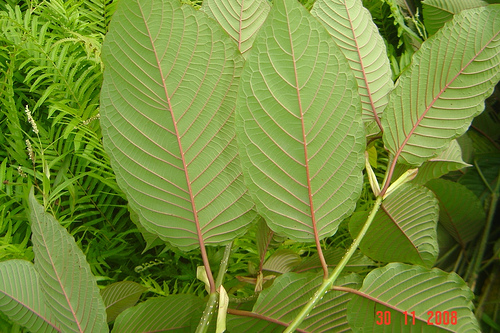Salvia divinorum – Traditional Method
Traditional Salvia divinorum use by the Mazatec people revolved around oral ingestion. The primary traditional method of use involves grinding large quantities of fresh salvia leaves and infusing water with them to make a salvia tea. This method has the drawback of being less potent because the active ingredient of salvia is poorly absorbed in the stomach. This is also a less attractive way of using salvia because the Salvia divinorum tea is extremely bitter and large quantities of it must be consumed for effects to be felt. The benefit of ingesting salvia orally is that the effects last longer than with other methods.
The other method of oral ingestion traditionally employed by the Mazatec is simply chewing and swallowing large quantities of leaves. This involves the same drawbacks and benefits as using a tea, but may be more potent, since salvia’s psychoactive ingredient (Salvinorin-A) is more readily absorbed by mucous membranes in the mouth than it is in the digestive tract.
At the 2008 World Psychedelic Forum in Basel, Switzerland, ethnobotanist Kathleen Harrison, described her experiences with the Mazatec Indians (see videos below), stressing that according to them the leaves must never be heated.
Salvia Usage – Modern Methods
Smoking Salvia
Smoking Salvia divinorum is a modern development. The primary consideration when smoking salvia is that a high temperature is required to vaporize the psychoactive chemical. Because of the difficulty in vaporizing salvinorin-a, large volumes of smoke need to be inhaled, and the smoke must be held in the lungs for a long period to maximize absorption. Smoking salvia in a cigarette is possible and some people experience effects from this method, but the most effective method for smoking salvia leaves is by using a water pipe. Smoking with a water pipe cools and condenses the smoke. This means that the smoke is less harsh, and it is easier to inhale a much larger quantity.
The benefit of smoking as a method of ingesting salvia is that the effects are more powerful than with other methods. When smoked, salvinorin-a is absorbed and metabolized quickly, so the hallucinogenic properties become apparent within moments of inhaling a few lungfuls of salvia smoke. The salvia effects brought about by smoking is more intense, but does not last as long as the trip from oral ingestion. The downside to smoking, of course, is the irritation to the lungs from the harsh smoke.
Chewing Salvia
A modern take on the traditional methods of use is chewing salvia in a manner similar to the way some tobacco users chew tobacco. Since it is now known that the gastrointestinal system largely deactivates salvia’s active compound, modern users maximize the potency of oral use by chewing fresh or re-hydrated leaves for long periods of time before swallowing them. Since the taste of Salvia divinorum is bitter and unpleasant, this method is not popular, but it is a viable alternative for users who are uncomfortable smoking, or who are seeking a longer lasting trip.
Salvia Tincture
Another modern method of oral ingestion is through the use of a tincture. A tincture is manufactured by extracting
salvinorin-a into a solvent. The tincture is then taken by dropping it under the tongue and letting it absorb into the bloodstream through the sub-lingual mucous membrane. The effects produced by consuming a salvia tincture vary depending on the potency of the particular tincture. Differences in manufacturing processes and raw materials leads to tinctures that can produce to mild effects as in traditional methods of use, or intense hallucinatory states the are similar to the effects of smoking salvia.
Using a salvia tincture gives the user all of the benefits of oral consumption, namely the extended duration of acute effects, without the drawbacks of unpleasant taste and mild psycho-activity.
Salvia Extract
The most popular method today, by far, is smoking Salvia divinorum extract. This happens to be the most widely available salvia for sale. As with tinctures, smokable extracts are produced by isolating salvinorin-a from salvia leaves through the use of solvents. As opposed to the final product being delivered in the solvent, however, manufacturing an extract involves producing pure salvinorin-a. To make the pure salvinorin-a smokable, it is used to fortify a small quantity of dried Salvia divinorum leaves. For example, a 20x salvia extract might fortify 5 grams of dried leaves with the pure salvinorin-a extracted from 100 grams of leaves, making those 5 grams 20 times more powerful.
Smoking salvia extract is clearly superior for users seeking the most powerful experience and the most reliable method of ingestion. Extract avoids the major difficulty of smoking normal leaves: vaporizing enough salvinorin-a. Because the extract leaves are fortified, much more of the active ingredient is present per a given volume of smoke. While normal salvia leaves may contain different levels of salvinorin-a, making the effects unpredictable and difficult to reproduce, users know exactly what they’re getting when smoking leaves fortified with pure salvinorin-a.
As a final note on Salvia divinorum methods of use, it’s important to remember that cultivation, handling and extraction processes all contribute the potency of any salvia obtained, so finding a quality supplier can be as important a factor as the method of ingestion.

